Comparison of Norwegian poultry, waterborne and clinical isolates of Campylobacter jejuni by ribotyping
Journal article, Peer reviewed
Published version
Permanent lenke
http://hdl.handle.net/11250/2437982Utgivelsesdato
2009Metadata
Vis full innførselSamlinger
Originalversjon
Journal of bacteriology research 1(2009) No 5, p. 51-57Sammendrag
Campylobacteriosis is the most frequently occurring food and waterborne gastroenteritis in Norway and 90% of cases are caused by Campylobacter jejuni. Campylobacteriosis is epidemiologically associated with use of non-disinfected water and consumption of contaminated poultry. In order to provide molecular epidemiological support for this association isolates from local poultry and water were compared with human isolates from domestic and import infections using ribotyping. Automatic riboprints were performed with the PstI restriction enzyme and RiboPrinter® and compared with a library of recognised patterns (DUP-IDs). Patterns were further compared with each other using GelCompar software. The isolates from human clinical cases showed high heterogeneity. DUP-IDs found among human isolates were also found in 2 isolates from poultry, DUP-PSTI-1146 and DUP-PSTI-2061. Two human isolates were like isolates from water, DUP-PSTI-2073 and DUP-PSTI-1122, but these were from patients infected abroad. This study provides limited support for the importance of poultry as a source of infection and illustrates the need for studies of much larger scope to encompass the huge diversity of strains and sources of C. jejuni.
